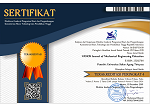Effectiveness of Peer Teaching Learning Models in Lathe Machinery Practice Courses for Mechanical Engineering Education Program Students
Abstract
The peer teaching learning model provides an opportunity for students to give each other knowledge to their peers. Peer teaching is a student-centred learning method. The purposes of this study are (1) to learn about the competence of students’ lathe practice after applying the learning model of peer teaching and (2) to know about the improvement of the competency of students’ lathe practice after applying the peer-teaching learning model. The method used in this research is quasi-experimental. The sample used in this research was 41 students of the Practical Class from the Mechanical Engineering Education Study Program. The data analysis used is normality test, homogeneity test, t-test, and N-Gain test. The results of the research show that (1) the competence of lathe practice of the students who apply a peer teaching learning model is in moderate categorized and (2) the application of a peer learning model is effective to improve the lathe practical competence of the students.
Keywords
Full Text:
PDFReferences
“Permendikbud-Nomor-38-Tahun-2020”.
S. SARUN, “PENINGKATAN HASIL BELAJAR PEMESINAN BUBUT SISWA KELAS XI TPA DENGAN METODE TUTORIAL TEMAN SEBAYA DI SMKN 1 CIKARANG SELATAN KABUPATEN BEKASI,” VOCATIONAL: Jurnal Inovasi Pendidikan Kejuruan, vol. 2, no. 2, pp. 136–145, 2022.
S. Hai-Jew, Practical Peer-to-Peer Teaching and Learning on the Social Web. in Advances in Educational Technologies and Instructional Design. IGI Global, 2021. [Online]. Available: https://books.google.co.id/books?id=NdNJEAAAQBAJ
R. K. Baltzersen, Effective Use of Collective Peer Teaching in Teacher Education: Maximizing Student Learning. in Routledge Research in Teacher Education. Taylor & Francis, 2023. [Online]. Available: https://books.google.co.id/books?id=35jeEAAAQBAJ
Y. N. Febianti, “Peer teaching (tutor sebaya) sebagai metode pembelajaran untuk melatih siswa mengajar,” Edunomic Jurnal Pendidikan Ekonomi, vol. 2, no. 2, 2014.
C. H. Major, M. S. Harris, and T. D. Zakrajsek, Teaching for Learning: 101 Intentionally Designed Educational Activities to Put Students on the Path to Success. Taylor & Francis, 2021. [Online]. Available: https://books.google.co.id/books?id=2t4zEAAAQBAJ
D. J. R. Evans and T. Cuffe, “Near‐peer teaching in anatomy: An approach for deeper learning,” Anat Sci Educ, vol. 2, no. 5, pp. 227–233, 2009.
T. O. Oziegbe, Introducing Peer Tutoring and Reciprocal Peer Tutoring in Colleges in Nigeria. GRIN Verlag, 2023. [Online]. Available: https://books.google.co.id/books?id=sHa6EAAAQBAJ
K. J. Graziano, “Peer teaching in a flipped teacher education classroom,” TechTrends, vol. 61, pp. 121–129, 2017.
R. K. Schutt, Investigating the Social World: The Process and Practice of Research. Pine Forge Press, 2009. [Online]. Available: https://books.google.co.id/books?id=Xl4caVEys_kC
C. S. Reichardt and T. D. Little, Quasi-Experimentation: A Guide to Design and Analysis. in Methodology in the Social Sciences Series. Guilford Publications, 2019. [Online]. Available: https://books.google.co.id/books?id=LNGlDwAAQBAJ
D. F. Chambliss and R. K. Schutt, Making Sense of the Social World: Methods of Investigation. Pine Forge Press, 2010. [Online]. Available: https://books.google.co.id/books?id=C_ykW73SbTcC
S. Sugiono, “Metode penelitian kuantitatif, kualitatif, dan r & d,” Bandung: Alfabeta, vol. 288, 2016.
M. Zozus, The Data Book: Collection and Management of Research Data. in Chapman & Hall/CRC Interdisciplinary Statistics. CRC Press, 2017. [Online]. Available: https://books.google.co.id/books?id=ilAsDwAAQBAJ
J. W. Creswell, Educational Research: Planning, Conducting, and Evaluating Quantitative and Qualitative Research. in Educational Research: Planning, Conducting, and Evaluating Quantitative and Qualitative Research. Pearson, 2015. [Online]. Available: https://books.google.co.id/books?id=6kk-nwEACAAJ
A. Ross and V. L. Willson, Basic and Advanced Statistical Tests: Writing Results Sections and Creating Tables and Figures. SensePublishers, 2018. [Online]. Available: https://books.google.co.id/books?id=qCdFDwAAQBAJ
K. Topping, C. Buchs, D. Duran, and H. van Keer, Effective Peer Learning: From Principles to Practical Implementation. Taylor & Francis, 2017. [Online]. Available: https://books.google.co.id/books?id=oTQlDwAAQBAJ
A. Burgess, D. McGregor, and C. Mellis, “Medical students as peer tutors: a systematic review,” BMC Med Educ, vol. 14, pp. 1–8, 2014.
N. Byrne and C. Butcher, An Introduction to Teaching in UK Higher Education: A Guide for International and Transnational Teachers. in ISSN. Taylor & Francis, 2020. [Online]. Available: https://books.google.co.id/books?id=FNQHEAAAQBAJ
S. Hidayat and M. Saleh, “Komparasi kemampuan kerja antara lulusan SMA dan SMK di industri permesinan modern,” IKRAITH-EKONOMIKA, vol. 2, no. 3, pp. 45–56, 2019.
D. E. McNabb, Research Methods for Political Science: Quantitative, Qualitative and Mixed Method Approaches. Taylor & Francis, 2020. [Online]. Available: https://books.google.co.id/books?id=E20LEAAAQBAJ
J. Durbin, Distribution Theory for Tests Based on the Sample Distribution Function. in CBMS-NSF Regional Conference Series in Applied Mathematics. Society for Industrial and Applied Mathematics, 1973. [Online]. Available: https://books.google.co.id/books?id=zAryCrT1IUYC
R. Romansyah, S. Wakhinuddin, and W. Wagino, “Penerapan Metode Pembelajaran Tutor Sebaya Dalam Meningkatkan Hasil Belajar Siswa Pada Mata Diklat Teknik Dasar Otomotif Pada Siswa Kelas X Program Keahlian Teknik Kendaraan Ringan Smk Negeri 1 Sumatera Barat,” Automotive Engineering Education Journals, vol. 7, no. 1, 2018.
H. Irawan, “Application of People Tutor Methods to Increase Learning Achievement of Mechanical Measuring Equipment to Basic Automotive Engineering,” VANOS Journal of Mechanical Engineering Education, vol. 8, no. 1, pp. 55–65, 2023.
N. P. Anggorowati, “Penerapan model pembelajaran tutor sebaya pada mata pelajaran sosiologi,” Komunitas, vol. 3, no. 1, 2011.
D. G. Young, D. E. Hoffman, and S. Frakes Reinhardt, “An exploration of the connection between participation in academic peer leadership experiences and academic success,” Journal of Peer learning, vol. 12, no. 1, pp. 45–60, 2019.
A. Wadi SMKN, J. Srikandi, and B. Korespondensi Penulis, “Penggunaan model peer teaching untuk meningkatkan motivasi dan prestasi belajar membuat batik tulis,” 2019.
J. Liou-Mark, U. Ghosh-Dastidar, D. Samaroo, and M. Villatoro, “The Peer-Led Team Learning Leadership Program for First Year Minority Science, Technology, Engineering, and Mathematics Students.,” Journal of Peer Learning, vol. 11, no. 5, pp. 65–75, 2018.
E. L. Rees, P. J. Quinn, B. Davies, and V. Fotheringham, “How does peer teaching compare to faculty teaching? A systematic review and meta-analysis,” Med Teach, vol. 38, no. 8, pp. 829–837, 2016.
C. A. Scott, A. McLean, and C. Golding, “How peer mentoring fosters graduate attributes.,” Journal of Peer Learning, vol. 12, no. 3, pp. 29–44, 2019.
E. T. Vasay, “The effects of peer teaching in the performance of students in mathematics,” E-International Scientific Research Journal, vol. 2, no. 2, pp. 161–171, 2010.
DOI: http://dx.doi.org/10.30870/vanos.v9i1.25842
Refbacks
- There are currently no refbacks.

This work is licensed under a Creative Commons Attribution 4.0 International License.


.png)
.png)
